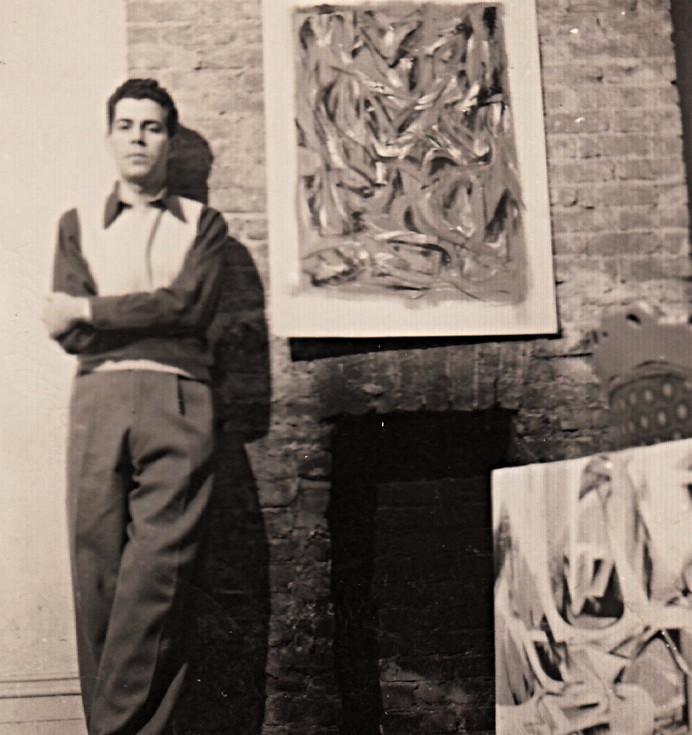
Raymond Spillenger was a member of the high-octane assemblage of highly-talented and charismatic artists known collectively as the New School. Their era was the 1950s and 1960s. They lived and worked in the neighborhood of East 10th Street and Fourth Avenue in New York. The stars were Willem de Kooning, Franz Kline, Philip Guston, Robert Motherwell and Jackson Pollock – a hard-drinking Bohemian crowd if ever there was. It was Picasso’s Montmartre transplanted to New York. Spillinger, however, felt out of his depth and was overwhelmed by this maelstrom of talent. What made things even worse was that he had no commercial ambitions. Eventually he became bitter, stopped showing his work and ceased painting altogether. In the 1990s he began again. No longer pressured to work in any particular style he came into his own with free-flowing abstractions displaying a hint of figuratism. He died last November. In cleaning out his studio his sons found a cache from this later period which has stirred up interest in the art market. Spillinger is finally on the verge of being noticed.
Robert Rauschenberg was another artist whose haunt was the East Village. But he looked further afield than Abstract Expressionism of the New School in which Spillinger felt trapped. Like them Rauschenberg was curious about how to use the electronic equipment that had become readily available but unsure how. Luckily a very different sort of scientist was in their circle called Billy Klüver, an electrical engineer from Bell Labs. He knew his way around the art community and helped them incorporate electronics into their art. This set the stage for collaborations between artists and scientists which have taken off in the twenty-first century. Unfortunately Spillenger missed out on this opportunity too which might have enabled him to work in a style of his own half a century ago.
See The New York Times: Raymond Spillenger of the New York School Gets Noticed and Chapter 2 of Colliding Worlds: How Cutting-Edge Science is Redefining Contemporary Art.
Greetings, and thanks for the post about my father, Ray Spillenger. I think the essential thrust of it is accurate, but a couple of things:
1. “Spillinger, however, felt out of his depth and was overwhelmed by this maelstrom of talent.” The name is “Spillenger,” with an ‘e’. And I think it’s misleading to say Ray felt out of his depth and overwhelmed — I can see how you might have gotten this impression, but I would say that while it’s true he had doubts, as most of us would in his shoes, he believed in his own work and stood toe to toe with several of the “greats” — Kline and de Kooning were both close friends; they considered Ray to be a great painter and encouraged him to show more than he did. Keep in mind that he was 20 years younger than de Kooning — definitely a member of the post-war second generation of abstract expressionists. I never knew him to express the kind of feelings you attribute to him.
2. “Unfortunately Spillenger missed out on this opportunity too which might have enabled him to work in a style of his own half a century ago.” This, too, is misleading. My father didn’t “miss out” on the opportunity to collaborate with scientists — he was completely uninterested in doing so. This was a quintessentially Rauschenberg thing to do, and not everyone was as enthusiastic as he was about the idea. More serious is the misconception that looking “further afield” than abstract expressionism (an ill-defined term to begin with) is necessary in order for an artist to develop his own style. There were painters that rebelled against abstract expressionism and got interested in other kinds of art; that doesn’t mean that everything else was a form of stagnation. The dominant presence in those days was de Kooning, and you had to deal with him. Everybody did. It would be inconceivable not to. Ray spent a couple of years with his “style,” because it was interesting to him and he could gain his own voice by grappling with it. If you actually look at a spread of Ray’s pieces over a 10-year period, and compare them to a spread of Bill’s, you will see that he quickly found a way to paint what he wanted to paint, in a way that was very different from that of his teacher. The New York Times put its own spin on the story (failed artist, blah, blah, blah), but I don’t think that in the end my father felt like a failure, nor do I think the growing number of critics, scholars and curators who are discovering him feel that way either. If he were simply a derivative abstract expressionist with no style of his own, I doubt this would be happening. Luckily, he didn’t need an electrician to do what mattered to him.
All this said, thanks again for the post. I appreciate it.
Paul
Somehow your very kind and informative note on my blog ended up marked as spam and I was just notified of it. I read with great interest your additions and corrections to the NYT article. Your comments brought out Ray’s human side and his own struggles in the whirlwind art world he inhabited.